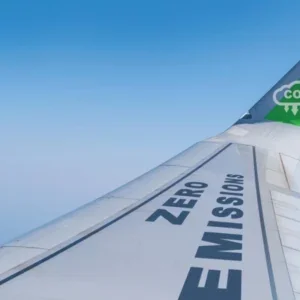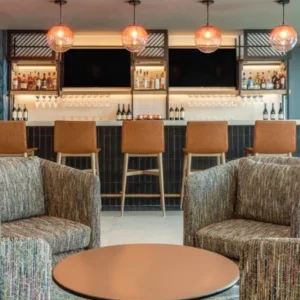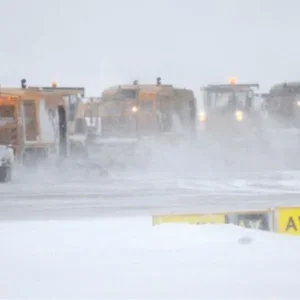According to the latest ACI statistics, the Middle East recorded year-on-year growth in domestic and international traffic of 18.5% in August 2013. And, with cities such as Abu Dhabi, Doha, Dubai, Istanbul and Riyadh all competing to construct the biggest, most state-of-the-art airport in the region and become international flight hubs -if they aren’t already – these numbers are set to increase further.
While Doha’s Hamad International Airport, set to open in 2014, will house the world’s second-longest runway, Istanbul and Dubai are battling it out for the title of the world’s largest airport. Abu Dhabi’s new international airport will even house a museum, intended eventually to pique passenger interest in the city’s cultural hub, the Saadiyat Cultural District, which will boast branches of the Louvre and the Guggenheim.
Of course, with airport openings, expansions and soaring passenger numbers come opportunities for travel retail and duty-free operators to increase revenue and play a larger role in promoting the countries in which they operate. In Dubai and Abu Dhabi, for example, many passengers are simply passing through, and an excellent shopping experience could mean the difference between choosing one of these cities for their next getaway and never coming back.
But, turning passengers into shoppers, and even potentially tourists, is no easy task, and for Sean Staunton, president of the Middle East and Africa Duty-Free Association (MEADFA), can only be achieved through collaboration – with airport operators, suppliers, regulators and even the competition.
"MEADFA has an excellent peer group working together and learning from each other’s expertise and experiences," he says. "The key objective of MEADFA is to continue to build the strong travel retail environment in our area."
Staunton explains further about how the region’s duty-free sector is responding to the huge growth it is experiencing, the training and networking opportunities available to operators looking to capitalise on this growth, and what the future holds for the industry.
Elly Earls: How does MEADFA work to raise awareness of the duty-free industry’s contribution to the greater travel and tourism industry infrastructure, and how much awareness is there of the importance of this contribution in the Middle East?
Sean Staunton: MEADFA raises awareness of the duty-free industry’s contribution through links between retailers and brand suppliers as well as organising seminars and conferences. We also represent the region’s duty-free industry with government agencies and the general travel industry.
Already, there is huge awareness of the importance of the duty-free industry in the Middle East. I think it punches quite well above its weight really. For example, when Dubai Duty-Free, which is part of the Dubai Government, was set up in 1983, one of its core activities was to promote the city of Dubai, as well as Dubai Duty-Free and Dubai International Airport.
Also, in general in the Gulf, there’s a huge amount of effort put into making airports run as smoothly as possible, but also making them look as nice as possible and to ensure the passenger has a good experience. We’re often asked the question: ‘Do people actually make a decision based on their experience in the airport when they’re booking a flight?’ And I would definitely say yes.
The duty-free sector is of huge importance to the revenue of airports. Are stakeholders in the Middle East aviation sector making the most of this?
Many airports in the Middle East and Africa are growing and, as a result, airport operators now realise the importance of non-aeronautical revenue in assisting the expansion of their airport. Also, the quality of travel retail, as well as food and beverage is seen as a reflection of the airport itself and there is, therefore, a significant drive by airports to have the best services available at their airport.
How important is collaboration between airport operators, duty-free operators and suppliers to ensure that countries in the Middle East capitalise on the huge growth across the sector, in terms of improving airport revenue and encouraging tourism?
A big part of MEADFA is about working together and sharing our experiences. For example, the MEADFA conference, which is held every year, is a conference with about 500 attendees, which attracts travel retailers, suppliers and airport operators. We encourage all three groups to work together.
We also have workshops and seminars where we, for example, get all the human resources managers together and they present case studies, discuss issues and get to know each other. Moreover, one of the most significant things we do is act as a peer group and that can come through in many different forms; for example, getting the staff in different duty-frees and airports to meet each other and share their experiences.
I would say the relationships between the different parties are definitely improving – not just in the Middle East, but throughout the world. Airport operators and duty-free operators are increasingly realising that they need each other; the airport is realising it is not just a physical building – it’s a physical building that also houses the food and beverage and the retail, and what happens inside that building is important to the airport.
Can you give an example of a particularly successful recent collaborative initiative in the Middle East?
We’re seeing more and more initiatives between ‘the trinity’- the airport, the supplier and the retailer. One good example of a recent collaboration is the partnership between Jack Daniels and Dubai Airport to open a new Bar and Grill.
They won an award at the recent Frontier Awards for a new concept between an airport, and a food and beverage outlet. It’s exciting to see things like that because we – as duty-free operators – don’t want passengers just to come and shop, we also want them to be in an environment where they feel comfortable.
What are the key challenges duty-free operators in the Middle East are facing as passenger numbers increase and airports continue expanding?
The numbers are continuing to grow so, from our side as retailers in the Middle East, the main challenge is trying to turn those passengers into shoppers. Whether you’re an airport with five million passengers or an airport with 66 million passengers, it’s all relative; you have the same challenges no matter what size airport or duty-free you are.
These challenges include: recruitment, staff training, ensuring that staff retain the culture of the company and ensuring that the right types of shops are in the right place and are offering the right product mix. But, if you have the right communication levels with the airport, the airport authority, the airlines and so on, and you’re prepared, yes, it’s a challenge, but it’s the right sort of challenge.
How important is it that MEADFA collaborates with the rest of the duty-free industry around the world to ensure the success of the sector whole?
I attended a recent meeting at the Tax Free World Association (TFWA) World Exhibition in Cannes in October 2013 that dealt with the changes that are happening in the regulation of LAGS (liquid aerosols and gels) from 31 January 2014 in Europe and the US, and that kind of information was important for MEADFA as well. The world is a big place; there are many airports, there are many duty-frees. But we all need to work together to try and do the right thing for the customer. For example, if you come to Dubai to buy an item and it is confiscated from you somewhere on your travels, you’ve had a bad experience not just in Dubai, but in the duty-free industry.
It was also officially announced at the conference that a Duty-Free World Council is being set up at the moment, through which the different travel retail and duty-free retailers around the world are going to come together within one body and continue the learning curve on how to deal with different challenges across the industry.






